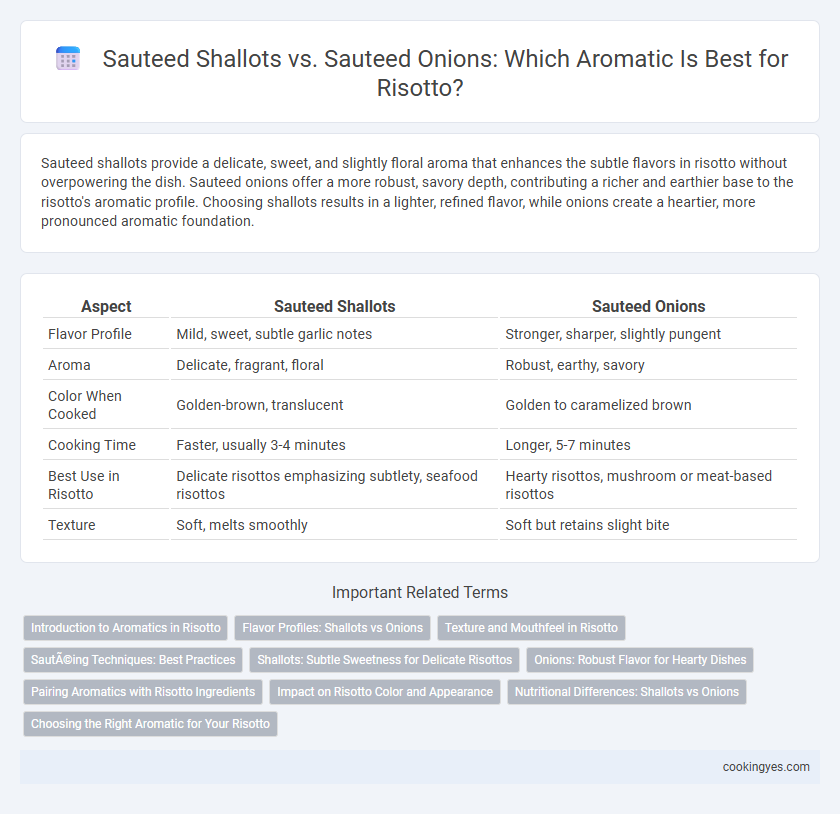Sauteed shallots provide a delicate, sweet, and slightly floral aroma that enhances the subtle flavors in risotto without overpowering the dish. Sauteed onions offer a more robust, savory depth, contributing a richer and earthier base to the risotto's aromatic profile. Choosing shallots results in a lighter, refined flavor, while onions create a heartier, more pronounced aromatic foundation.
Table of Comparison
| Aspect | Sauteed Shallots | Sauteed Onions |
|---|---|---|
| Flavor Profile | Mild, sweet, subtle garlic notes | Stronger, sharper, slightly pungent |
| Aroma | Delicate, fragrant, floral | Robust, earthy, savory |
| Color When Cooked | Golden-brown, translucent | Golden to caramelized brown |
| Cooking Time | Faster, usually 3-4 minutes | Longer, 5-7 minutes |
| Best Use in Risotto | Delicate risottos emphasizing subtlety, seafood risottos | Hearty risottos, mushroom or meat-based risottos |
| Texture | Soft, melts smoothly | Soft but retains slight bite |
Introduction to Aromatics in Risotto
Sauteed shallots provide a delicate, slightly sweet flavor that enhances the creamy texture of risotto without overpowering it, making them an ideal aromatic choice. Sauteed onions offer a bolder, more robust taste that imparts a deeper savory base to the dish, contributing to a heartier flavor profile. Both aromatics play a crucial role in developing the foundational flavor of risotto by releasing natural sugars and complementing the starchiness of Arborio rice.
Flavor Profiles: Shallots vs Onions
Sauteed shallots offer a delicate, sweet, and slightly garlicky flavor that elevates risotto's aromatic complexity without overpowering the dish. In contrast, sauteed onions provide a robust, earthy sweetness with a more pronounced savory depth, contributing a heartier base flavor to the risotto. Choosing shallots enhances the subtlety and refinement of the risotto, while onions deliver a richer, more intense aromatic foundation.
Texture and Mouthfeel in Risotto
Sauteed shallots provide a delicate texture and a subtle sweetness that enhances the creamy mouthfeel of risotto, offering a refined aromatic layer without overpowering the dish. In contrast, sauteed onions contribute a more robust texture and a stronger, earthier flavor that adds depth but can slightly alter the velvety consistency of the risotto. Choosing shallots results in a smoother, more nuanced aromatic profile, while onions bring firmer texture and a heartier taste to the final dish.
Sautéing Techniques: Best Practices
Sauteed shallots offer a delicate, sweet flavor and softer texture that enhances risotto's aromatic profile, while sauteed onions provide a more robust, caramelized taste ideal for heartier dishes. Best practices for sauteing include using medium heat to avoid burning, stirring frequently to ensure even browning, and cooking until translucent to release optimal flavors without bitterness. Choosing between shallots and onions depends on the desired flavor intensity and texture to complement the risotto's creamy consistency.
Shallots: Subtle Sweetness for Delicate Risottos
Sauteed shallots provide a subtle sweetness that enhances the delicate flavors of a risotto without overpowering its creaminess. Their fine texture and gentle aroma blend seamlessly, creating a nuanced base that elevates the dish's overall complexity. Shallots are preferred over onions for risottos where balance and refinement are key aromatic elements.
Onions: Robust Flavor for Hearty Dishes
Sauteed onions provide a robust, caramelized flavor that deepens the heartiness of risotto, making them ideal for rich, savory dishes like mushroom or beef risotto. Their natural sweetness and slightly pungent aroma enhance the overall complexity, offering a strong aromatic base compared to the milder, more delicate shallots. Using onions as aromatics ensures a bold foundation that complements and intensifies the savory ingredients in traditional risotto recipes.
Pairing Aromatics with Risotto Ingredients
Sauteed shallots offer a delicate, sweet aroma that enhances creamy risotto base flavors without overpowering delicate ingredients like seafood or mushrooms. Sauteed onions deliver a robust, caramelized depth, complementing heartier risotto additions such as sausage, wild game, or aged cheeses. Choosing shallots or onions depends on balancing the aromatic profile to highlight the primary risotto components and maintain flavor harmony.
Impact on Risotto Color and Appearance
Sauteed shallots impart a delicate, pale golden hue to risotto, preserving its creamy and light appearance, while sauteed onions typically deepen the color to a richer amber tone. The milder flavor of shallots enhances the aromatic profile without darkening the rice, maintaining a visually appealing, bright presentation. Choosing shallots over onions benefits risotto dishes where a refined, subtle color and elegant look are desired.
Nutritional Differences: Shallots vs Onions
Sauteed shallots contain higher levels of antioxidants and vitamin A compared to sauteed onions, contributing to enhanced nutritional benefits in risotto dishes. Onions provide more vitamin C and dietary fiber, aiding digestive health. Incorporating shallots adds a subtly sweeter and more complex flavor while boosting the dish's micronutrient profile.
Choosing the Right Aromatic for Your Risotto
Sauteed shallots offer a milder, sweeter flavor profile that subtly enhances the delicate creaminess of risotto without overpowering its texture. On the other hand, sauteed onions provide a more robust and pronounced savory note, adding depth and earthiness to the dish. Selecting between shallots and onions depends on the desired aromatic intensity and complexity, with shallots favored for refined, delicate risottos and onions preferred for heartier, rustic variations.
Sautéed shallots vs Sautéed onions for aromatics Infographic

 cookingyes.com
cookingyes.com